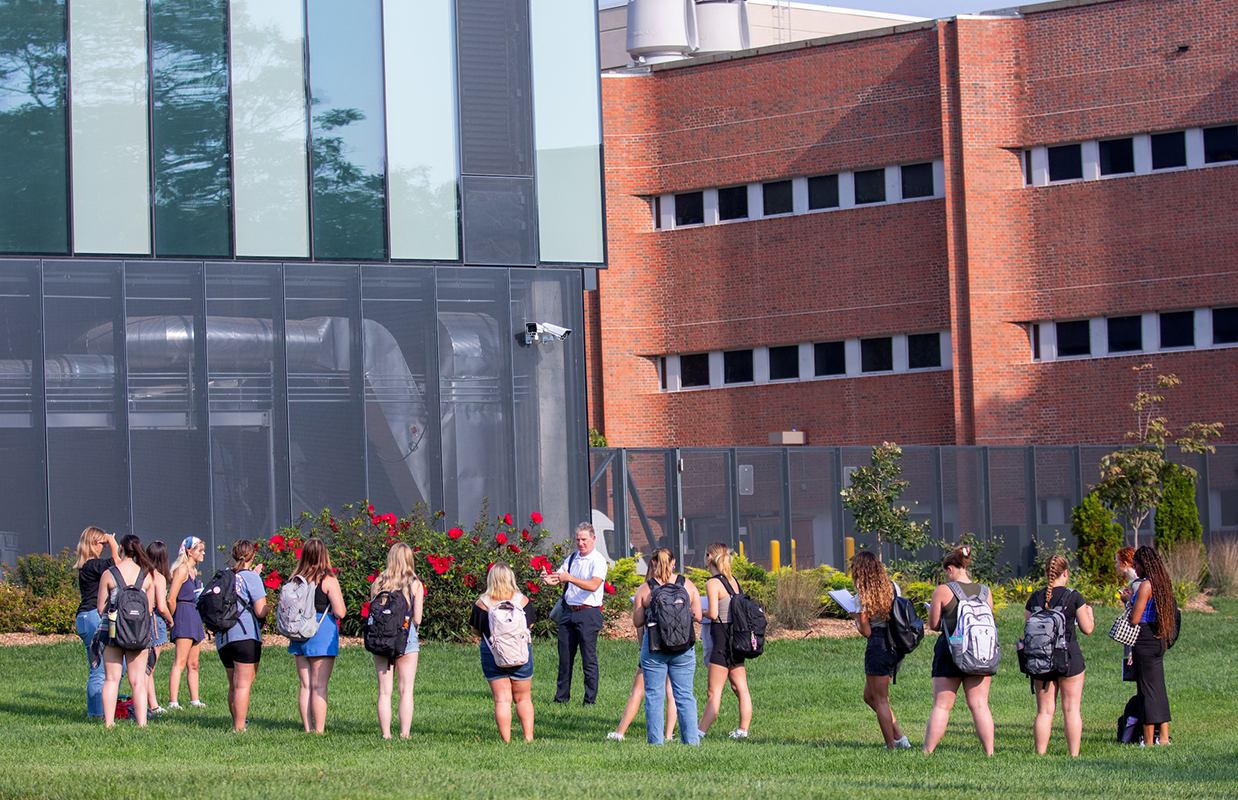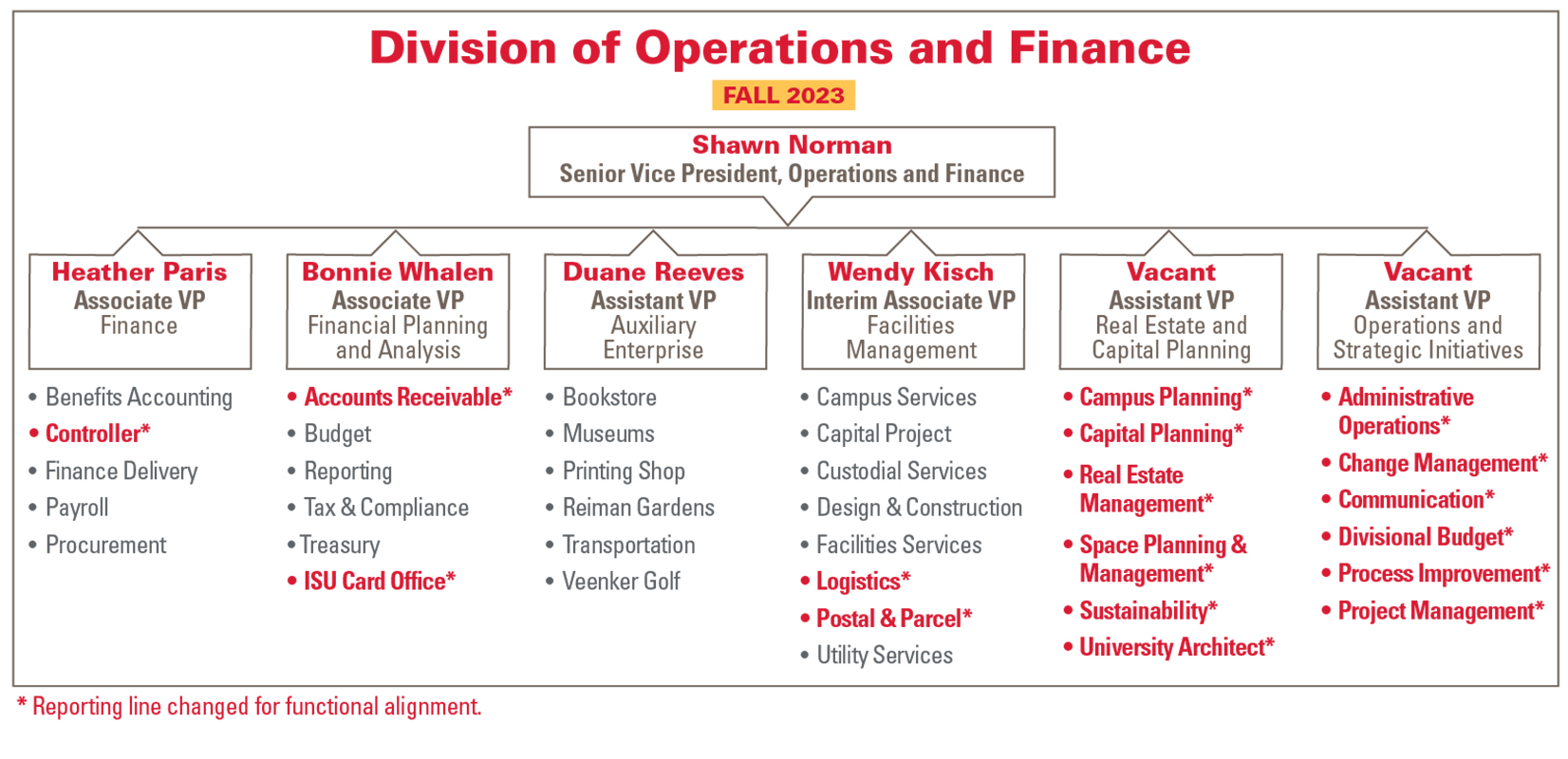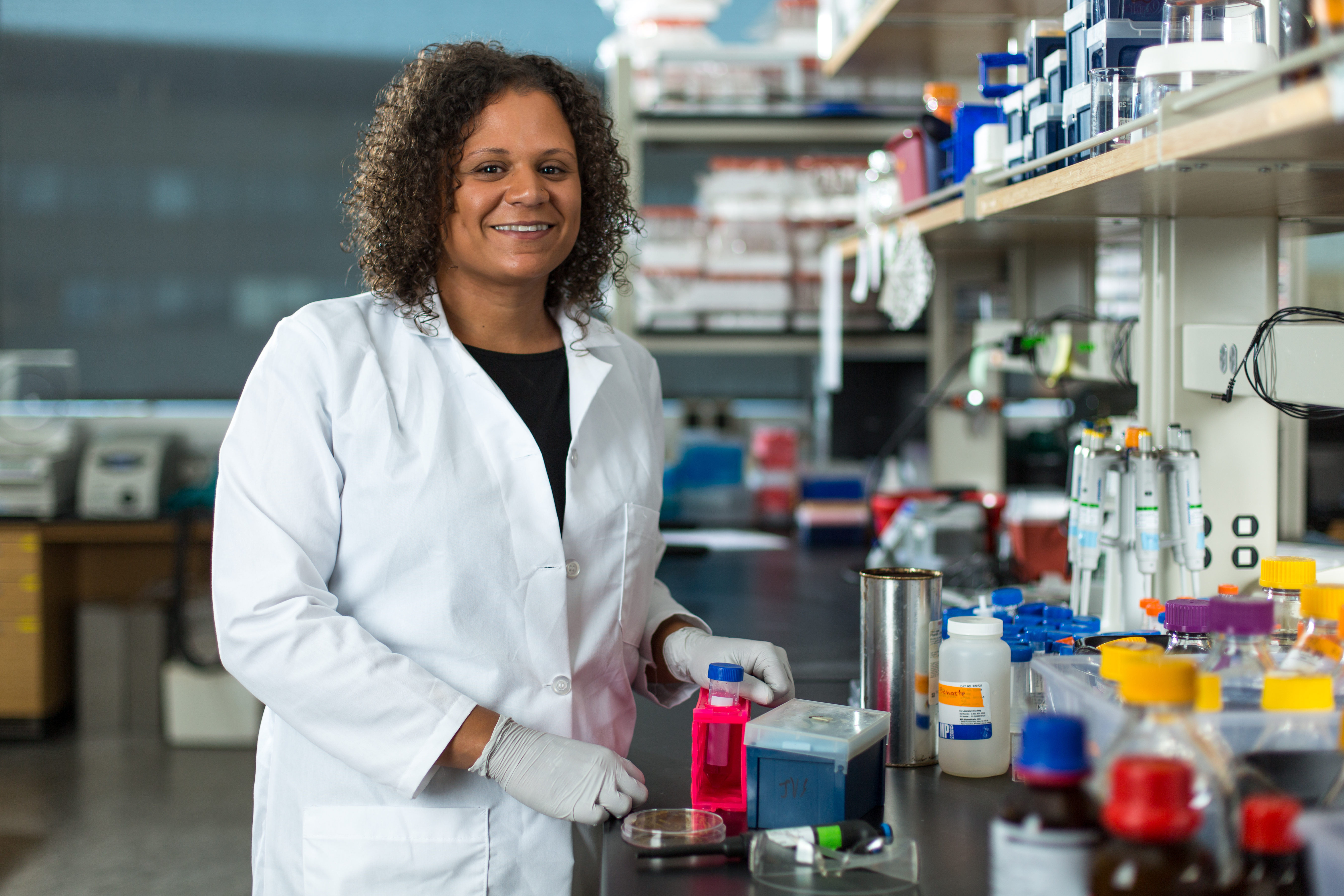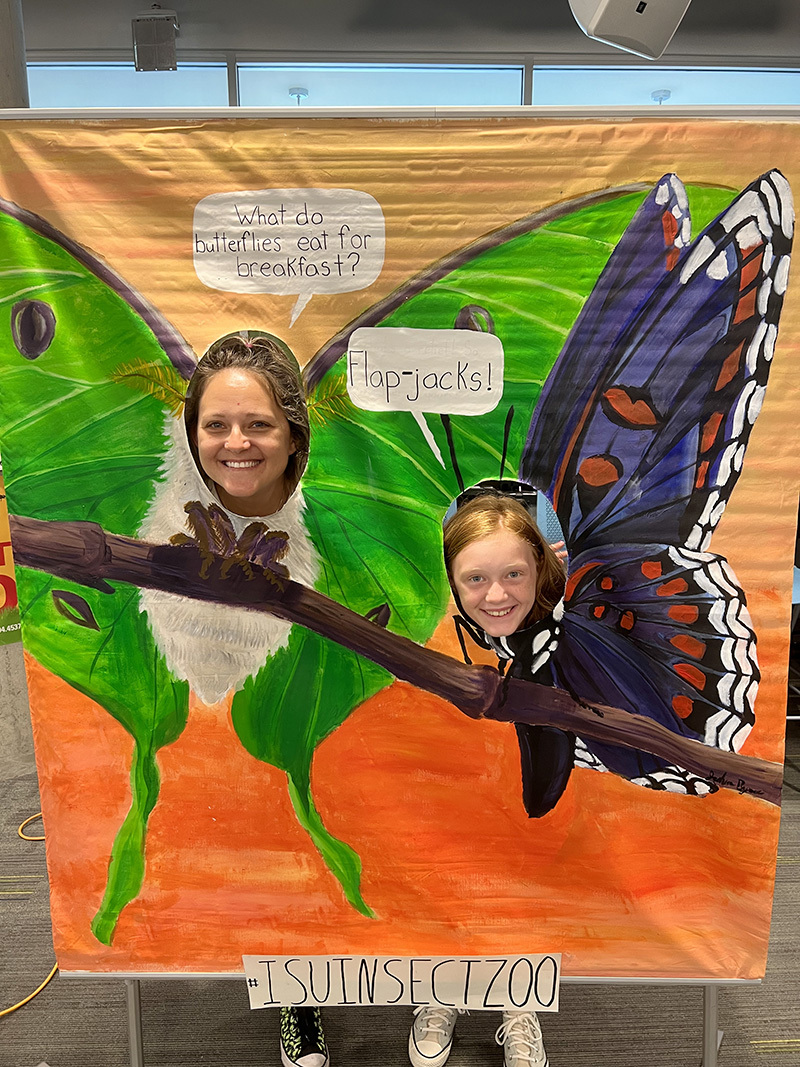First class on the first day

Taking advantage of the early-morning climate, Michael Ford (center), associate professor of practice in interior design, ventured outside with his 7:45 a.m. class, an interior design studio, on the first day of fall semester. Behind Ford are the Student Innovation Center (left) and Sweeney Hall. Photo by Christopher Gannon.
Uncertain about AI in your teaching? Here's some help.
Artificial intelligence (AI) quickly is becoming ubiquitous in our personal and professional lives, including higher education. That's why, over the last year, Iowa State has added several programs that support faculty in response to the technology and its impact on teaching courses and student learning.
"While some schools have tried to ban or control the use of AI tools, our approach is to recognize that this technology, like other disruptive technologies before it, needs to be understood and integrated into our academic programs," said senior vice president and provost Jonathan Wickert. "It's also a critical part of our mission to train students for the modern workforce, where employers expect graduates to understand and responsibly use AI."
Here's a quick look at resources for faculty:
1. Last spring, the Center for Excellence in Learning and Teaching (CELT) team developed resources for syllabi options depending on the extent to which AI is incorporated (or not) in a course, as well as ideas for faculty to consider when creating assignments and assessments.
2. This semester, faculty may participate in seminars offered through the AI in Teaching Series. Presentations from last semester's seminar series were recorded and are available, too. The next session, "How to Teach with Generative AI: Supporting Students and Designing Learning Experiences," will be held Oct. 13 and features faculty from the department of English.
3. CELT recently launched a professional development course to help faculty understand the pedagogical and ethical implications of AI in the classroom. "Teaching with AI" is an asynchronous course in Canvas that includes modules on:
- How students are using AI tools.
- How to design or redesign courses that may be disrupted by AI.
- Adjustments to exams, papers and projects that reflect the availability of AI.
Registration is available online.
Sara Marcketti, assistant provost and CELT executive director, said faculty taking the Canvas course may participate either individually or in a cohort to be held twice during the academic year, in November and February.
"This learning community, much like those offered to our undergraduate students, will bring together faculty interested in AI to engage with the course content, share best practices and learn from each other," she said.
Wickert said multiple departments and interdisciplinary teams are considering new courses, programs, and initiatives in AI -- including in research, and extension and outreach. In addition, an "AI Across the Curriculum" initiative is under development this semester to support faculty who plan to create or refresh courses with AI in mind.
CELT offers two new learning communities for faculty
Much like helping students adapt at the start of a new academic year, the Center for Excellence in Learning and Teaching (CELT) is putting the focus on instructors with two new faculty learning communities.
How to participate
Schedules for all learning communities are on the CELT events page. An RSVP is requested.
The Large Enrollment Learning Community will meet the first Friday of every month (1 p.m., 2030 Morrill) beginning Sept. 1, and the New Instructor Teaching and Learning Community has its first meeting Sept. 11 (2 p.m., 2030 Morrill).
"These two communities were developed because of needs expressed by faculty across campus," said CELT instructor development coordinator Krista Klocke. "Community is such a vital aspect of building a sense of belonging and feeling connected on campus. Teaching can sometimes feel solitary, or like you are the only one dealing with a particular challenge, or wondering how best to meet student needs in the classroom."
Klocke said learning communities for faculty can help. As they create connections within the learning community, instructors help one another while giving and receiving encouragement and support. Talking about a topic with another instructor can yield helpful insights.
The in-person learning communities are designed to promote conversation and shared ideas on how to excel in situations and overcome challenges. There now are four CELT faculty learning communities. The other two are the ISU Online Learning Community, which supports instructors of online courses, and the Teaching with AI asynchronous Canvas course.
Large enrollment
The large enrollment community will be co-facilitated by four faculty members who helped design it and will guide conversation. Ecology, evolution and organismal biology adjunct associate professor Lori Biederman, chemistry teaching professor Cristina Bonaccorsi, Morrill Professor of mathematics Steve Butler and psychology associate teaching professor Bob Hessling all have experience teaching large enrollment courses. Klocke also will co-facilitate the community.
"Instructors in large enrollment courses are teaching in a different format that requires different kinds of support," she said. "We want this to be the community of practice for those teaching large enrollment courses."
The conversations and information gathered throughout this academic year will lead to the development of an online teaching toolkit that will be officially launched by fall 2024 and made available to all faculty. Klocke said it will provide an overview of what it's like to teach a large enrollment course with strategies and suggestions for success.
New instructors
The new instructor community is for those new to teaching or to Iowa State. It will be co-facilitated by accounting associate professor Christine Denison and Klocke. Klocke said one of the biggest goals is to help alleviate some of the stress that comes with teaching for the first time, teaching a new course or teaching on a new campus, by building community and offering support through interdisciplinary connections. A new instructor teaching toolkit also will be developed and launched for all instructors next fall.
Attend when you can
Attendance isn't mandatory, so faculty can choose which sessions of each learning community fit their schedule. The learning communities will run through the academic year but pause during winter session.
For more information about any of the faculty learning communities, email Klocke.
Operations/finance division realigns to serve the campus

Larger image. Graphic by Deb Berger.
The division of operations and finance will implement several changes this semester to realign functions and strengthen how its units work together and serve the campus community. The initial changes include creating two assistant vice president positions (operations and strategic initiatives; real estate and capital planning), changing the reporting line for a handful of units and tweaking the names of the functional areas to reflect those changes.
Following a division assessment and recommendations this spring by the business advisory consultant, Grant Thornton, senior vice president for operations and finance Shawn Norman shared the changes with division employees last week. Norman said the changes will improve the efficiency of operational processes and are consistent with best practices in higher education.
"The intent is to bring together people doing similar work who, in the past, were on different teams," Norman said. "It's really about aligning our service functions to better serve the campus."
Functional realignment
Norman said a search is underway for a new assistant vice president for operations and strategy. This leader has responsibility for administrative operations, change management, communications, the divisional budget, process improvement and projects within the division.
Norman said he is working with university human resources (UHR) to create another leadership position, assistant vice president for real estate and capital planning, and begin that search later this fall. This new functional area essentially aligns the many services in the previous facilities planning and management (FPM) into two groups.
- The leader in the new position will oversee campus master planning, capital planning, real estate management, space planning and management, sustainability and the university architect. This unit will manage pre-planning and the approval process, while the renamed facilities management will manage construction.
- The facilities management unit retains the capital projects oversight and design and construction functions, as well as care and maintenance of buildings and grounds: campus services, custodial services, facilities services, and utility services.
"These two groups really have a different purpose," Norman said. "One is maintaining what we have and the other operates more in the realm of what could come to fruition if funding is available."
Also by late fall, Norman said a search will launch for a permanent vice president for facilities management. Wendy Kisch, director of operations for the Student Innovation Center with previous experience in FPM, is serving in this leadership post for the interim.
New reporting lines
The transition process is underway for two units, logistics and support services and postal and parcel services, to report to the associate vice president of facilities management. Formerly, they were part of auxiliary enterprises.
On Sept. 1, these reporting-line swaps will take effect:
- University controller will report to the associate vice president of finance, Heather Paris.
- Accounts receivable and the ISU Card office will report to associate vice president of financial planning and analysis, Bonnie Whalen.
Up next
Norman said he has asked the division's associate and assistant vice presidents to consider changes within their units that would further improve efficiency within the division and, ultimately, service to the campus community.
Five questions with the Science Bound director

Science Bound director Alexis Campbell. Submitted photo.
A Des Moines native and ISU alumna, Alexis Campbell discovered a passion for blending research with classroom experience during a National Science Foundation (NSF) research experience her sophomore year and never looked back. She went on to serve as an NSF Graduate STEM Fellow in K-12 Education, associate scientist and graduate faculty member in the Roy J. Carver department of biochemistry, biophysics and molecular biology and director for teaching-as-research projects at ISU. In 2017, she was named the first full-time director of the Science Bound program.
"I met amazing researchers who showed me that you can give back to people being in a lab," said Campbell, who came to ISU with plans to become a doctor. "Being able to mentor students while I was in the lab -- some of who were Science Bound students -- was very close to my heart. When I had the opportunity to be the director, it felt right."
Name: Alexis Campbell
Position: director, Science Bound
Education: B.S. in biology and Ph.D. in biochemistry, biophysics and molecular biology, both from Iowa State
Interested in volunteering? Email Science Bound
Who does Science Bound serve?
We work with four Iowa school districts -- Des Moines, Denison, Marshalltown and Clarke -- to provide programming for students in grades 8-12 and their families. We have around 450 to 500 students across all grades and districts. At least 75% of our students are first-generation and even more would be considered low-income, so we start meeting with families in eighth grade to build trust and help them support their students along the way.
Science Bound started with a pilot program in the late 80s. Several of our founders were chemistry professors -- which is why we're housed in Gilman Hall. They partnered with faculty in the School of Education to create the program with the goal of encouraging students who historically are underrepresented to look at careers in education and ASTEM (agriculture, science, technology, engineering and math).
Pre-college Science Bound students can earn a full tuition scholarship to attend ISU. How many choose that option?
They have to meet requirements, like maintaining a 3.0 or higher GPA and attending our summer programs, to qualify for the scholarship, and the majority who earn it come to Iowa State. In the past three years, around 98% of our pre-college students went directly to college and approximately 70% of those students have come to Iowa State. We always hope they choose to come here, but first and foremost, we are a college prep program and the goal is simply that Science Bound scholars go to college.
What role do Science Bound alumni play in the program?
Science Bound alumni include students who complete the pre-college program and earn a scholarship to Iowa State but choose to go elsewhere, as well as those who ultimately come to Iowa State and graduate from here. When alumni come to Iowa State, we have opportunities for them to become program leaders who help host activities on campus and travel with us to the school districts. It's great to have college students and alumni stay involved with the pre-college scholars so these students can see what their future could look like. Science Bound alumni are role models for current students -- they motivate students and help them see the value of the program.
Who else do you rely on for support?
Corporate partners see the value of Science Bound and play a crucial role in supporting our mission. Students learn about potential career paths when we take them on field trips to businesses and they listen to speakers from various industries. Two of our districts -- Denison and Clarke -- became part of Science Bound because corporate partners came to us and said they wanted to do something to give back to the families who work for them. In those districts, the corporate partners fully fund the program.
There's a community of giving within industry and also an understanding that they need a diverse workforce -- and this is an opportunity to prepare students to be future candidates.
Why do you like your job?
The eighth graders in Science Bound when I started six years ago are in college now, and I've seen a whole life cycle of college graduates since becoming director. It's really important to build connections with students in this program, and you have these kinds of 'proud mom' moments when you get to see them grow and succeed. All along my own journey, I've had really great mentors, and that ability to be a mentor was part of what really attracted me to serve in this role.
One of the best parts of Science Bound is helping students find their fit in different fields. The other morning, I was at Gym-N-Eat, a cricket farm. The students were touring there and got to try roasted crickets and cricket bars. I don't know if anyone will go on to become a cricket farmer, but being able to explore all kinds of fields is exciting. And to see their faces when those experiences happen is so impactful.
ISU police department assists with security at Mary Greeley Medical Center
What began on a small scale has turned into a significant community partnership between the ISU police department and Mary Greeley Medical Center. In June, the two organizations entered into an agreement for the department to provide 24/7 security at the hospital.
"It started in 2018 doing about 80 hours a week with a police officer there mostly during evening hours," said associate vice president and chief of police Michael Newton. "Unfortunately, violence in the health care setting has increased over the last decade."
The police department provides one officer -- usually a public safety officer -- for each of three eight-hour shifts, and the hospital covers the cost of round-the-clock security. The officer's primary responsibility is to ensure safety of employees and patients in the emergency department, but several other tasks will be developed in the months ahead. They include:
- Completing safety checks around the hospital's internal and external spaces.
- Assisting with combative patients.
- Participating in various safety and security trainings.
- Answering questions from hospital staff and dealing with parking issues.
"Mary Greeley is a safe place, but medical facilities throughout the country are seeing more incidents of violence. Having trained Iowa State officers at the hospital provides another level of security that is much appreciated by our staff, patients and visitors," said Dieter Friton, director of Emergency Services and Mobile Intensive Care Services for the medical center.
The agreement also allows hospital employees to use the Iowa State Safe mobile app. It's customized for them but retains many of the same features, such as monitored walks to their vehicle, Newton said.
Newton said he is in the process of hiring more public safety officers to supplement the five currently on staff as they continue their duties across campus. Using public safety officers allows police officers to focus on other duties and is one of the primary reasons ISU is better suited for the service than Ames police officers.
Newton hopes to have eight safety officers and a supervisor, who will oversee them, to fulfill duties on campus and at the hospital. The public safety officer program began last fall and already saw one of its members become an ISU police officer.
"We hope this will give our public safety officers experience with de-escalation and working and talking with people," Newton said. "Many of them want to be police officers in the future, so we see this as a way for them to build their skillset."
Community presence
Newton said having an officer at the hospital full time is important because so many students, faculty and staff use Mary Greeley or take part in internships there.
"Mary Greeley is a huge part of our community, and having a safe environment when you are a patient or for the staff is key," Newton said. "This is a step forward and we are building community at the same time."
Don't bug out. Bug Village offers learning opportunity

Bug Village has plenty of activities for families in a fun learning atmosphere. Contributed photo.
Want to see the largest collection of living arthropods in the country? Saturday, Aug. 26's Bug Village '23 is the place to be with 200 species on display.
Update
The Insect Zoo welcomed 169 baby tarantulas confiscated from the Port of Los Angeles in February. Some spiders have been sent to other institutions, but Mitchell said "they are thriving and getting much larger." One of the tarantulas will be on display at Bug Village.
"We are a traveling zoo so we don't typically get to host something like this at our facilities," said Ginny Mitchell, Insect Zoo education program coordinator. "This is our opportunity to show off every single animal we have at the Insect Zoo, and it is a huge event where we see over 1,000 people. I'm not aware of another collection of living arthropods bigger than this."
Bug Village, which dates back to 2015, starts at 11 a.m. with an open house on the first floor of the Advanced Teaching Research Building (2213 Pammel Dr.). It is followed by an "Insect Collecting 101" demonstration hosted by the entomology graduate student organization, and the event concludes in the evening at the city's Carr Park (Meadowlane Avenue and Carr Drive in east Ames) for insect light collecting.
Mitchell spends a year planning the event and will be assisted by six student workers and seven volunteers during activities. Two of Mitchell's former students are returning to campus this weekend to help. Parking lots north and west the Advanced Teaching Research Building will be available.
The events
Everything from mealworms to Hercules beetles will be on display during the open house (11 a.m.-2 p.m.) with plenty of animals for attendees to touch. It is free and open to the public with activities to keep children entertained. New this year is a Pollinator Olympics, which helps children understand how much work pollinators do.
"Bees carry 35% of their weight in pollen on their legs, so we are going to have children see if they can carry 35% of their weight using sandbags on their legs to mimic carrying pollen from the flower back to the hive," Mitchell said. "We also will have some fan favorites there like cockroaches and the infamous stink beetle, which often gets confused with the stink bug."
The Iowa Monarch Conservation Consortium will provide materials for a plant-your-own pollinator pot for young attendees and students who don't have a large lawn to attract pollinators. There will be roach races and a contest to name the roach racetrack.
Registration is required for "Insect Collecting 101" (2:30-5 p.m.) and cost $5 ($20 including a pinning kit). Graduate students will teach about insects and how to collect and preserve them.
"A pinning kit includes a box to put your insects in, special pins to use on insects and a pinning block," Mitchell said.
The insect light collecting event (7-10 p.m.), which was canceled last year because of the weather, is free and open to the public. Blacklights at two stations will let participants observe which insects are attracted to the light, and several ISU entomologists will be on hand to help identify them.
